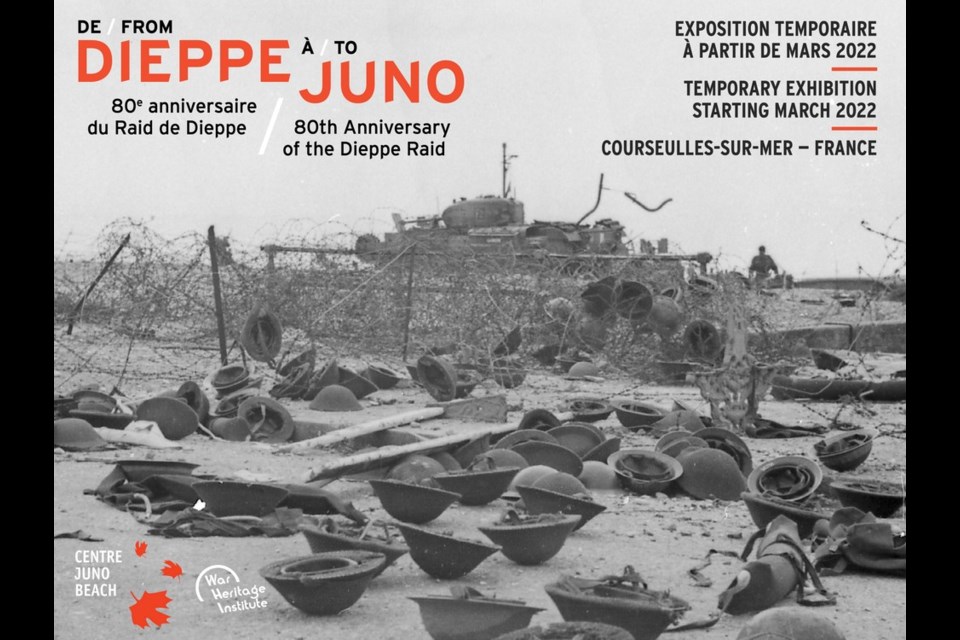The Juno Beach Centre has launched a temporary exhibit called From Dieppe to Juno: The 80th Anniversary of the Dieppe Raid, produced in partnership with the War Heritage Institute and sponsored by Seaspan Shipyards.
The War Heritage Institute is based in Brussels, Belgium, while Seaspan Shipyards is located in Vancouver, British Columbia.
The exhibit runs until Saturday, Dec. 31, 2023, in Courseulles-sur-Mer, France.
From Dieppe to Juno features 72 different artifacts and personal testimonies from men who participated in or were affected by the raid. Visitors will be thrust into the tense context of 1942, the height of the Nazi regime’s powerful grip over Europe.
Casualties were so high during the Dieppe Raid on Aug. 19, 1942, that artifacts were difficult to secure.
“The objects we did find are quite powerful and reveal the significance of the raid,” said Marie Eve Vaillancourt, the Juno Beach Centre’s director of exhibitions.
“Each of them is a true treasure. They will help the JBC tell the story of the Dieppe Raid through the individuals who experienced the raid and whose artifacts we will be showcasing. Their presence in France will help visitors understand the legacy of the Dieppe Raid and keep its memory alive for future generations.”
Eighteen artifacts came from Canadian lenders, museums or family collections. Ryan Goldsworthy, museum director and curator of the Royal Canadian Military Institute (RCMI) Museum in Toronto, one of Canada’s oldest and largest military museums, says the RCMI is delighted by the partnership.
“As part of this exciting exhibition and commemorative project in France, we have shared a number of high-profile artifacts from our museum’s extensive Second World War collection,” Goldsworthy. “These exceptional artifacts, which include an original ‘most secret’ 1942 Dieppe Raid map and a one-of-a-kind prisoner of war flag presented to the Canadian liberators in 1944, will help to shape and illuminate the historical narrative.”
“It is our shared hope and vision,” he added, “that many thousands of Canadians and European residents will visit and participate in this upcoming exhibition!”
The museum of the Royal Regiment of Canada, the Toronto-based infantry battalion that suffered some of the operation’s worst casualties, also stepped up.
Richard Towey, museum director and curator, says, “The Dieppe raid was one of the first steps that Canada undertook to return freedom to France and the rest of Europe. These artifacts, especially the rare set of shackles, illustrate the harsh conditions suffered by Canadian soldiers who endured 32 months of captivity as prisoners of war.”
The Dieppe Raid was the Canadian Army’s first major combat against Germany during the Second World War. It was planned as a one-day operation conducted primarily by Canadian troops, with land, air and naval support from British and American troops. Its official objective remains shrouded in mystery and is the subject of widespread mythology and controversy.
Within fewer than 10 hours of fighting, two-thirds of a force of 4,963 Canadians were wounded, captured or killed. More than 900 Canadian soldiers were killed in action or died of wounds, almost 600 of whom remain buried in the Dieppe Canadian War Cemetery in Hautot-sur-Mer, France.
The legacy of the Dieppe Raid extends beyond borders and time. In re-telling the story, From Dieppe to Juno explores the effects of that legacy through various experiences of witnesses from all walks of life.
The Dieppe Raid remains one of the most identifiable events in Canadian Second World War history. For many decades, it occupied a greater place in the collective memory of Canadians than the Normandy landings of D-Day in 1944.
It was not until recent years that the events at Juno Beach have caught up with Dieppe in Canadian memory. This new exhibition explores how the mythology linking the horror at Dieppe to the success of the Canadians on D-Day has evolved over time.
Long remembered as a tragic failure, the story of Dieppe is as complex as it is nuanced. Historians have intensely studied it over the decades, while scholars and hobbyists continue to debate it.
For visitors learning about the topic for the first time, From Dieppe to Juno provides an accessible, factual overview of the planning, the raid, and its aftermath. For more knowledgeable visitors, the exhibition will also delve into facets of the raid not often explored.
Visit www.junobeach.org for more information.


.png;w=120;h=80;mode=crop)

